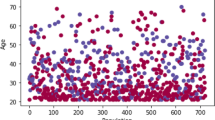Abstract
The medical model that uses artificial intelligence technology to assist diagnosis and treatment is called smart medicine. It can learn the medical knowledge of experts, and can simulate the thinking and reasoning of doctors to give patients a reliable diagnosis and treatment plan. The purpose of this article is to help young doctors with uneven distribution of medical resources and insufficient experience by exploring the application of artificial intelligence neural networks in the intelligent diagnosis of diabetes. This paper proposes to use BP neural network and probabilistic neural network to model diabetes diagnosis. First, the number of hidden layer units of BP network is selected according to the input feature vector. The training effect is best when the number of hidden layer units is 12, and the diagnostic accuracy rate is 91.7% through experiments. Then built a PNN network model, using 75% of the data for training, 25% of the data for testing, and testing the effectiveness of the network model. The diagnostic accuracy was 97.9%. Finally, the accuracy of the 20 neural network models was tested 20 times. After a comparative analysis, it is concluded that the PNN network model is better than the BP neural network model in terms of performance and accuracy. Compared with the traditional diagnosis process, the neural network-based diagnosis model can effectively save doctors time and improve diagnosis efficiency.








Similar content being viewed by others
References
Cecotti H (2016) Hierarchical K-nearest neighbor with GPUs and a high performance cluster: application to handwritten character recognition. Int J Pattern Recognit Artif Intell 31(02):1022–1026
Choi YJ, Baek JH, Park HS et al (2017) A computer-aided diagnosis system using artificial intelligence for the diagnosis and characterization of thyroid nodules on ultrasound: initial clinical assessment. Thyroid 27(4):546
Ding X, He Q (2017) Energy-fluctuated multiscale feature learning with deep ConvNet for intelligent spindle bearing fault diagnosis. IEEE Trans Instrum Meas 66(8):1–10
Dong W, Liu M-M, Wang L-S et al (2018) Fault diagnosis for railway turnout control circuit based on group decision making. Acta Automatica Sinica 44(6):1005–1014
Fu Y, Wang S, Wang C-X et al (2018) Artificial intelligence to manage network traffic of 5G wireless networks. IEEE Netw 32(6):58–64
Gandhimathi T (2018) An application of intuitionistic fuzzy soft matrix in medical diagnosis. J Comput Theor Nanosci 15(3):781–784
Karimzadehfini A, Mahdavinejad R, Zolaktaf V et al (2017) Forecasting of rehabilitation treatment in sufferers from lateral displacement of patella using artificial intelligence. Sport Sciences for Health 14(6):1–9
Lee EJ, Kim YH, Kim N et al (2017) Deep into the brain: artificial intelligence in stroke imaging. J Stroke 19(3):277–285
Liu R, Meng G, Yang B et al (2017) Dislocated time series convolutional neural architecture: an intelligent fault diagnosis approach for electric machine. IEEE Trans Ind Inf 13(3):1310–1320
Lopes BT, Eliasy A, Ambrosio R (2019) Artificial intelligence in corneal diagnosis: where are we? Curr Ophthalmol Rep 7(3):204–211
Magos D, Mourtos I (2017) Submodularity and its application to some global constraints. Ann Math Artif Intell 79(4):1–23
Massalha S, Clarkin O, Thornhill R et al (2018) Decision support tools, systems, and artificial intelligence in cardiac imaging. Can J Cardiol 34(7):827
Mazinan AH, Khalaji AR (2016) A comparative study on applications of artificial intelligence-based multiple models predictive control schemes to a class of industrial complicated systems. Energy Syst 7(2):237–269
Momeni-Boroujeni A, Yousefi E, Somma J (2017) Computer-assisted cytologic diagnosis in pancreatic FNA: an application of neural networks to image analysis. Cancer 125(12):926
Nema MK, Khare D, Chandniha SK (2017) Application of artificial intelligence to estimate the reference evapotranspiration in sub-humid Doon valley. Appl Water Sci 7(5):1–8
Neocleous AC, Nicolaides KH, Christos N (2016) Intelligent non-invasive diagnosis of aneuploidy: raw values and highly imbalanced dataset. IEEE J Biomed Health Inform 21(5):1–1
Paschali K, Tsakona A, Tsolis D et al (2017) Steps that lead to the diagnosis of thyroid cancer: application of data flow diagram. Ifip Adv Inf Commun Technol 382(3):56–65
Sangnes DA, Softeland E, Biermann M et al (2016) Gastroparesis—causes, diagnosis and treatment. Tidsskr Nor Laegeforen 136(9):822–826
Selvarajah A, Bennamoun M, Playford D et al (2018) Application of artificial intelligence in coronary computed tomography angiography. Curr Cardiovasc Imaging Rep 11(6):12
Voss F, Eckardt L, Busch S et al (2016) AV-reentrant tachycardia and Wolff-Parkinson-White Syndrome: diagnosis and treatment. Herzschrittmachertherapie Elektrophysiologie 27(4):381–389
Wen J, Yan C, Sun J et al (2018) Bearing fault diagnosis method based on compressed acquisition and deep learning. Yi Qi Yi Biao Xue Bao/Chin J Sci Instrum 39(1):171–179
Wu J (2018) The next era: flourish of national health care and medicine with the world leading artificial intelligence. Chin Med Sci J 34(2):69–70
Xu J, Tan Y, Zhang M (2017) Medical imaging in tumor precision medicine: opportunities and challenges. Zhejiang da xue xue bao Yi xue ban Journal of Zhejiang University Medical sciences 46(5):455–461
Yang YJ, Bang CS (2019) Application of artificial intelligence in gastroenterology. World J Gastroenterol 25(14):1666–1683
Zhang R, Ding G, Zhang F et al (2017) The application of intelligent algorithm and pulse coupled neural network in medical image process. J Med Imaging Health Inform 7(4):775–779
Author information
Authors and Affiliations
Corresponding author
Additional information
Publisher's Note
Springer Nature remains neutral with regard to jurisdictional claims in published maps and institutional affiliations.
Rights and permissions
About this article
Cite this article
Li, X. Artificial intelligence neural network based on intelligent diagnosis. J Ambient Intell Human Comput 12, 923–931 (2021). https://doi.org/10.1007/s12652-020-02108-6
Received:
Accepted:
Published:
Issue Date:
DOI: https://doi.org/10.1007/s12652-020-02108-6




